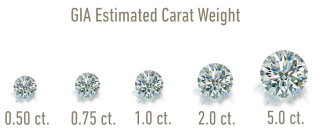
It's GIA Laboratory and diamond industry practice to weigh diamonds to a thousandth of a carat, then round the weight to a hundredth of a carat. You round the weight up ony if the number in the thousandths place is 9 or more.
For example, you'd round a diamond that weights 1.568cts to 1.56, but one that weighs 1.569cts to 1.57cts.
The weights of diamonds and most other gems are expressed in metric carats. One metric carat equals 0.200grams (200milligrams or 1/5grams).
A carat is divided into 100 equal units called points.
According to US Federal Trade Commission ruli8ngs, all weight representations are subject to a 1/200 carat (one-half point) tolerance.
If other factors are equal, the more a stone weights, the more valuable it will be.
Some weights are considered "Magic sizes":0.5ct, 0.75ct, 1.00ct, 2.00ct, 5.00ct. Visually, there's little difference between a 0.99ct diamond and a 1.00ct diamond. But the pirce differences between the two can be significatn.
People tend to prefer certain sizez over others. These Magic sizes also greatly affect the loos diamonds price. For example, a 1.00ct diamond is considereed to be a Magic size. If a loose diamond weights 0.99ct, the price per carat will be much cheaper than one of the same color, clarity, cut and finish(polish and symmetry) that weights 1.00ct